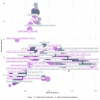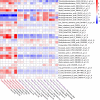Transcriptomic analysis of deceptively pollinated Arum maculatum (Araceae) reveals association between terpene synthase expression in floral trap chamber and species-specific pollinator attraction
- PMID: 35861391
- PMCID: PMC9434142
- DOI: 10.1093/g3journal/jkac175
Transcriptomic analysis of deceptively pollinated Arum maculatum (Araceae) reveals association between terpene synthase expression in floral trap chamber and species-specific pollinator attraction
Abstract
Deceptive pollination often involves volatile organic compound emissions that mislead insects into performing nonrewarding pollination. Among deceptively pollinated plants, Arum maculatum is particularly well-known for its potent dung-like volatile organic compound emissions and specialized floral chamber, which traps pollinators-mainly Psychoda phalaenoides and Psychoda grisescens-overnight. However, little is known about the genes underlying the production of many Arum maculatum volatile organic compounds, and their influence on variation in pollinator attraction rates. Therefore, we performed de novo transcriptome sequencing of Arum maculatum appendix and male floret tissue collected during anthesis and postanthesis, from 10 natural populations across Europe. These RNA-seq data were paired with gas chromatography-mass spectrometry analyses of floral scent composition and pollinator data collected from the same inflorescences. Differential expression analyses revealed candidate transcripts in appendix tissue linked to malodourous volatile organic compounds including indole, p-cresol, and 2-heptanone. In addition, we found that terpene synthase expression in male floret tissue during anthesis significantly covaried with sex- and species-specific attraction of Psychoda phalaenoides and Psychoda grisescens. Taken together, our results provide the first insights into molecular mechanisms underlying pollinator attraction patterns in Arum maculatum and highlight floral chamber sesquiterpene (e.g. bicyclogermacrene) synthases as interesting candidate genes for further study.
Keywords: Chemical ecology; GC–MS; RNA-seq; molecular ecology; plant-pollinator interactions; sesquiterpenes.
© The Author(s) 2022. Published by Oxford University Press on behalf of Genetics Society of America.
Figures





Similar articles
-
Subtle ecophysiological divergences in a deceptive strategy to attract the same pollinators in two sympatric Arum.Ann Bot. 2025 Jun 10:mcaf090. doi: 10.1093/aob/mcaf090. Online ahead of print. Ann Bot. 2025. PMID: 40492467
-
Antennae of psychodid and sphaerocerid flies respond to a high variety of floral scent compounds of deceptive Arum maculatum L.Sci Rep. 2022 Mar 24;12(1):5086. doi: 10.1038/s41598-022-08196-y. Sci Rep. 2022. PMID: 35332183 Free PMC article.
-
Incomplete synchrony of inflorescence scent and temperature patterns in Arum maculatum L. (Araceae).Phytochemistry. 2018 Oct;154:77-84. doi: 10.1016/j.phytochem.2018.07.001. Epub 2018 Jul 10. Phytochemistry. 2018. PMID: 30006091
-
β-Ocimene, a Key Floral and Foliar Volatile Involved in Multiple Interactions between Plants and Other Organisms.Molecules. 2017 Jul 13;22(7):1148. doi: 10.3390/molecules22071148. Molecules. 2017. PMID: 28703755 Free PMC article. Review.
-
Volatile Organic Compounds from Orchids: From Synthesis and Function to Gene Regulation.Int J Mol Sci. 2020 Feb 10;21(3):1160. doi: 10.3390/ijms21031160. Int J Mol Sci. 2020. PMID: 32050562 Free PMC article. Review.
Cited by
-
Molecular basis for thermogenesis and volatile production in the titan arum.PNAS Nexus. 2024 Nov 4;3(11):pgae492. doi: 10.1093/pnasnexus/pgae492. eCollection 2024 Nov. PNAS Nexus. 2024. PMID: 39544499 Free PMC article.
-
Gene expression and metabolite levels converge in the thermogenic spadix of skunk cabbage.Plant Physiol. 2024 May 31;195(2):1561-1585. doi: 10.1093/plphys/kiae059. Plant Physiol. 2024. PMID: 38318875 Free PMC article.
-
Fine-tuned terpene synthase gene expression, functional promiscuity, and subcellular localization: implications for the evolution of complex floral volatile bouquet in Caladenia orchids.Plant Cell Physiol. 2025 May 17;66(4):627-644. doi: 10.1093/pcp/pcaf026. Plant Cell Physiol. 2025. PMID: 40056156 Free PMC article.
References
-
- Alexa A, Rahnenfuhrer J. topGO: Enrichment Analysis for Gene Ontology. R Package Version 2.0; 2010.
-
- Barthlott W, Szarzynski J, Vlek P, Lobin W, Korotkova N.. A torch in the rain forest: thermogenesis of the Titan arum (Amorphophallus titanum). Plant Biol. (Stuttg). 2009;11(4):499–505. - PubMed
Publication types
MeSH terms
Substances
LinkOut - more resources
Full Text Sources
Miscellaneous
